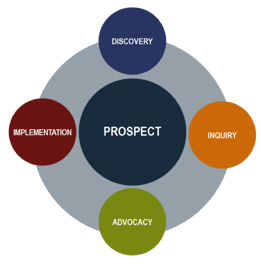Understanding The Advocacy Segment In the Multifamily Sale
by Doug Davidoff | Oct 9, 2014 12:00:00 AM
 In most selling systems a tremendous amount of emphasis is placed on the presentation and closing abilities of salespeople. Phrases like “Always Be Closing,” and “Close Early and Close Often” are commonplace among sales teams.
In most selling systems a tremendous amount of emphasis is placed on the presentation and closing abilities of salespeople. Phrases like “Always Be Closing,” and “Close Early and Close Often” are commonplace among sales teams.
Yet, increasingly research from organizations like the Sales Executive Council, Forrester and others demonstrate that these approaches, while occasionally producing short-term results are ineffective over the longer term and create a number of negative consequences in the process.
As we shared a couple of weeks ago on this blog, the real leverage point in any interaction between a buyer and seller lies in the ability to ask resonating questions, influence the prospect’s assessment of a situation and demonstrate an understanding of their unique situations--a segment we call Inquiry.
We regularly advise salespeople and sales leaders that the key to shortening the sales decision time is to slow the process down. The most common (and one of the biggest) mistake made by salespeople of all types in virtually all industries is jumping too quickly to what we refer to as advocacy mode.
They simply start making recommendations before they’ve earned the right (and the trust) to do so. Why do they do this? First, Advocacy tends to be more fun for people than Inquiry, and it’s certainly more comfortable for them. Advocating is simple, while inquiring is more complex. When you’re advocating you’re dealing with what you know (or at least what you think you know), while inquiring requires that you deal with the unknown.
The last reason that salespeople jump to advocacy too early is that they know what’s needed, before the prospect does. So, the salesperson often thinks inquiry is done before it actually is. This is why it’s important that sales leaders create clear milestones that indicate to the salesperson when an inquiry has been effectively completed.
The Keys to Successful Advocacy
Inquiry is done when the salesperson has a clear understanding of who the prospect is, what makes them unique and what’s motivating them. With that and a mutual understanding of what’s desired, the salesperson is ready to leave Inquiry and move to the next segment of the sales process, Advocacy.
While it should go without saying, a salesperson should only advocate their product, service or solution when it’s in the interest of the prospect. It is critical that the conversation between prospect and seller always maintain authenticity. The moment a salesperson puts “making the sale” ahead of doing what’s right for a prospect, a number of negative consequences occur.
Remember, prospects already knows a tremendous amount about the options that are available to them, and the moment they feel out of alignment with the salesperson they’re likely to jump.
In multifamily there are two key components to the Advocacy segment:
- The Price Conversation. Discussing price is often a challenging activity for sales associates, particularly new ones. An effective process recognizes this. Building on its core principles of transparency and authenticity, it reminds associates that most prospects already know the price and focuses them on how to confidently present their value proposition and answer any questions about price and value.
- The Tour. This is the single most important and impactful activity leasing associates perform. While related to any sales presentation, it’s unique to the multi-family industry. We teach associates how to take their knowledge of the prospect’s Buying Style and tailor their tour accordingly.
When an effective Inquiry and Advocacy have occurred, moving to the closing sequence becomes a natural, comfortable part of the process.